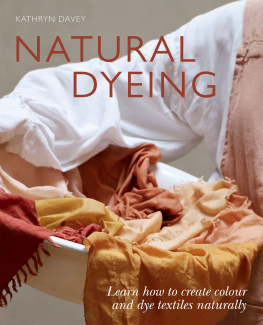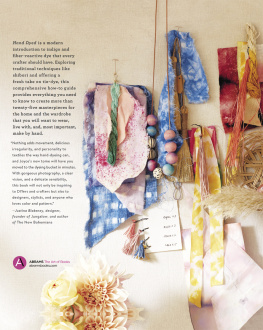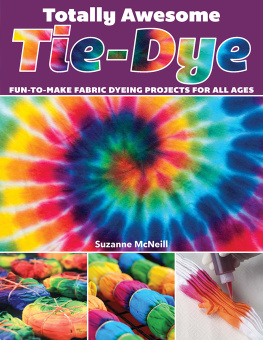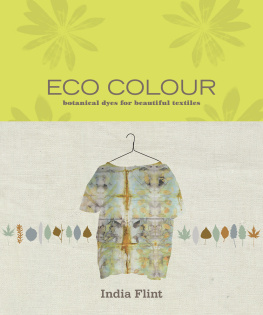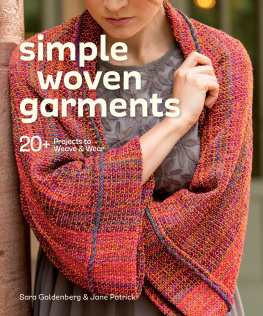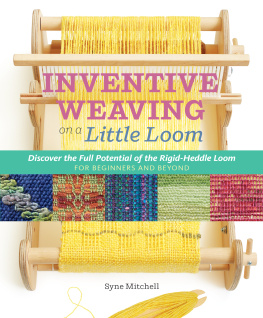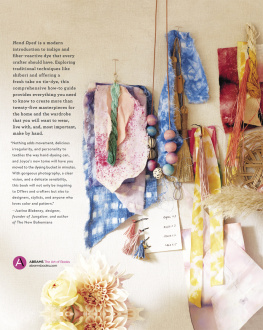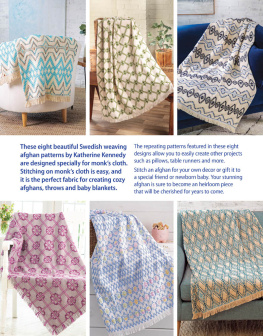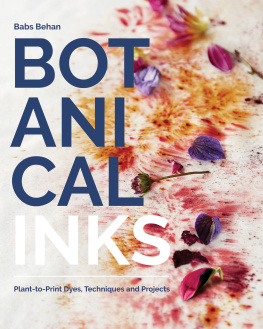
Catharine Ellis

contents
Resources
For Kent, Hanni, and Nick.
Foreword
In the late 1960s and early 1970s, weaving was the predominant means of expression in the fiber arts movement. Fascination with other forms of fiber art, such as tie-dye and batik, was sparked by youth who traveled east, seeking meaning in the ancient cultures and religions of Asia. Deeply impressed by the beauty and cultural significance of the textiles they encountered, they strove to create equivalents. The Dyers Art: Ikat, Batik, Plangi (1976) by Jack Lenor Larsen and others opened the door to surface design for fiber artists and stimulated the formation of the Surface Design Association. Ikat is a unique combination of weaving and dyeing; groups of warp or weft yarns are bound tightly and resist dyed before weaving. The pattern is thus woven and integrated into the fabric, not applied superficially to the surface. After reading The Dyers Art, Catharine Ellis embarked on a long exploration, expanding the language of ikat.
The emerging field of surface design was defined as the coloring, patterning, structuring, and transformation of fabric, fiber, and other materials. As artists explored the aesthetic possibilities in cloth, the fiber arts movement, and surface design in particular, evolved rapidly, incorporating a constant stream of new technology, often in combination with indigenous and traditional hand techniques. In the last decade, artists have become more responsive to the materials they use for their artistic expressions and more aware of the environmental and social impacts of their art-making processes. Catharines work is a manifestation of this heightened artistic and environmental consciousness.
After conducting courses introducing Japanese shibori, starting in 1975 in Berkeley, California, I coauthored Shibori: The Inventive Art of Japanese Shaped Resist Dyeing in 1983, examining and exploring shiboris dynamic approach to patterning and surface design, which transcends the limitations of the static two-dimensional paradigm typical of wax resist, paste resist, or ikat. I met Catharine in 1990 at Penland School of Crafts in North Carolina, where she attended a class I was teaching on Japanese textile history. After spending a week experimenting with nui shibori, placing stitches on silk and then gathering them to create a resist before dyeing, it was only natural that she would think about applying the technique to weaving, the craft that she had been practicing since the late 1970s. She was excited to realize that she could use weft floats in weaving like the stitching threads in nui shibori. Tightening the float created a puckered surface, which served as a shaped resist for dyeing. The float was then removed and the integrity of the cloths weave structure maintained. Woven shibori revealed itself as the perfect marriage of the weavers and the dyers arts.
As Catharine experimented with translating the running stitches of mokume (wood grain) shibori, a simple but laborious technique, into the language of weaving, she discovered possibilities for gathering and binding, using other weave structures with which she was familiar, such as monks belt, twills, and laces. She introduced the idea of combining weaving and shaped-resist dyeing in the first edition of this book in 2005, applying her accumulated knowledge of woven shibori, artfully designing her weave structure and carefully selecting her fibers. Now, in this revised edition, Catharine covers a broad selection of natural dyes. She taps into a limitless reservoir of possibilities with each new project, using well-tested natural dyeing processes. Her pioneering work gives the fiber artist options for creating a canvas where the intuitive and tactile visual language of shibori interfaces with weavings precise mathematical structures, thus expanding and strengthening textile art. In addition, she has generously included details of her experimentation with natural dyes and colors on selected natural fiberswork she began when she participated in the filming of the instructional video I produced of Michel Garcias Natural Dye Workshop.
Catharines textile art practice continues to evolve. She infuses traditional textile craft with the spirit of scientific experimentation, which she also applies to growing plants and creating her own dyes. Her conceptual creations explore the meaning and potential of natural colors rather than simply substituting natural for synthetic dye powders in an age when using natural dyes has become trendy. All the parts of her work harmonize and support one another, resulting in living art that is delightful to behold.
Yoshiko Iwamoto Wada
Preface
Every designer, every artist, every discoverer of something new is in that sense an amateur and to explore the untried he must be an adventurer. For he finds himself alone on new ground. He is left to his own devices and must have imagination and daring. All decisions here are his own, and only he is responsible. But though it is he who is in charge, he feels himself to be only an intermediary who is trying to help the not-yet-existent turn into reality.
Anni Albers
Woven Shibori was first published eleven years ago. It has been a link between me and weavers and dyers all over the world. Sharing the process through the book and teaching the technique has been an adventure and a privilege. Some weavers have been able to learn the process on their own with the book, and I have taught woven shibori to others all over the world: Europe, Asia, Australia, and North America. In India we used the finest of silks woven on pit looms to create woven shibori designs.
Woven shibori continues to be an excellent way for both new and accomplished weavers to experience the process of transformation in their work. A simple textile can become alive and personalized through woven resist dyeing. The principles and technical aspects of woven shibori have not changed in these eleven years. They are timeless and have become part of the weavers vocabulary. Weavers and dyers worldwide have adopted woven shibori as a viable part of their own practice.
I have not stopped learning, and each day in the studio brings new ways of combining weaving, resist, and dye. Two important developments have influenced my work during these years: Jacquard weaving and natural dyes.
When first introduced to Jacquard (a mechanical or computerized device that controls the lifting of warp threads), I applied those principles to woven shibori. It has allowed me to weave fabrics far more complex in design and concept than those woven with a harness loom. Related to this, I have had the opportunity to work with the Oriole Mill in Hendersonville, North Carolina, which specializes in computerized Jacquard weaving in small runs. The mill weaves fabrics for me that include shibori-gathering threads. These are all made to my own designs and specifications on natural fibers. This experience has taught me a great deal more about woven structure, fabric development, and design. The combination of industrial machine weaving and the hand processes of gathering and dyeing results in a unique handcrafted textile.
Not all fabrics are suitable for industrial production, and I do still weave many fabrics by hand, but the use of industrial weaving has allowed me to bring woven shibori to non-weavers, teaching the principles of woven shibori and its relationship to resists and dye processes. It has also given me more freedom to focus on dyeing.
Next page

